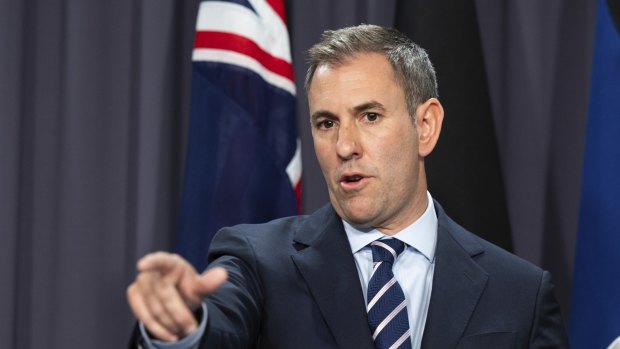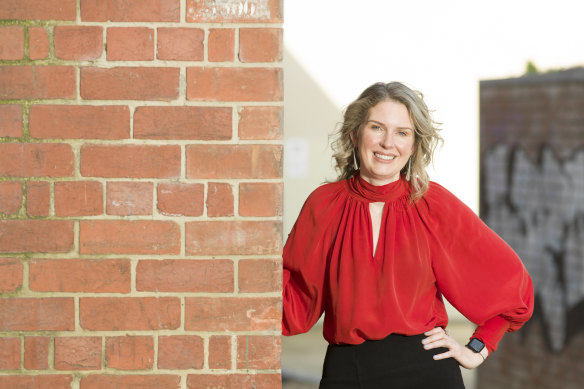Treasurer Jim Chalmers has signalled huge public spending to kickstart a new era of green industries for Australia, which is needed to slash emissions and grow the economy while traditional mainstays in coal and gas decline.
Chalmers, speaking at The Australian’s Economic and Social Outlook Conference in Melbourne on Thursday morning, said the government was developing a “uniquely Australian” strategy to tap into global green investment that would drive economic change similar to that the country went through in the 1950s and 1980s.

Treasurer Jim Chalmers has used a speech to reveal plans to modernise the Australian economy to deal with plans to cut greenhouse gas emissions.Credit: Alex Ellinghausen
Chalmers said he was developing a policy agenda that focused on Australia’s advantages.
“Our plan will be ambitious, but uniquely Australian – focused on Australia’s strengths, on renewable energy, resources, our reputation as a trusted and reliable trading partner, on our people, and our knowledge.”
Governments around the world are ramping up public investments to develop clean industries to reach net zero emissions by 2050, most notably the United States’ through its Inflation Reduction Act, which some analysts believe could deliver up to $US1 trillion in industry subsidies and has been described as a “global capital vortex” sucking up green investment from all over the world.
Australia’s emissions policies have focused largely on swapping out coal and gas power for renewables but Chalmers said to deliver on the net zero pledge, farmers, builders, manufacturers and miners will be recruited to play a bigger role in the green revolution under specific plans for each sector of the economy.
Erwin Jackson, policy director at the Investor Group on Climate Change, which represents institutional investors with more than $30 trillion of funds under management, said Australia was already trailing the global pack and would struggle to compete for investment without a policy overhaul.
“If we don’t get credible sector plans and we don’t have a clear national sector-by-sector road map to deliver net zero in an orderly and just way, then investors are going to continue to put their money in markets that have more attractive long-term returns,” Jackson said.
Prime Minister Anthony Albanese, in a speech on Thursday, also signalled a more forceful industry policy, saying the government was committed to strengthening the country’s economic resilience and self-reliance to protect Australians from future shocks.
“Our nation is no longer at the mercy of the tyranny of distance, we now hold the opportunity of proximity. And our government wants to make this count,” he said.
“In areas such as battery manufacturing and using green hydrogen to produce green steel and other products, we are determined to do just that.”
Chalmers said the government was already investing $40 billion into making the country a renewable energy superpower but more money, both private and public, would be necessary to undertake the type of change required to meet Australia’s emissions objectives.
The treasurer said the government could not compete with the scale of the US’ scheme and would target public investment in domestic opportunities with the largest prospects for economic growth and jobs, which he listed as battery making, refining and processing to add to Australia’s mining of critical minerals, green hydrogen and green metals.
“We won’t realise Australia’s unique geographical, geological, geopolitical, intellectual and meteorological advantages by designing an Inflation Reduction Act Lite – looking only for big numbers but missing the bigger picture,” Chalmers said.
He said a skilled workforce, support for untested technologies and the strengthening of supply chains would all play a critical part in transforming the economy.
Acting opposition leader Sussan Ley said the government’s climate plan was undermined by its “impossible” goal to boost the share of renewables to 82 per cent of the grid by 2030. The opposition would instead focus on promoting the use of gas, which she claimed would lower energy costs, reduce business’ operating costs and attract new industrial investment.
Ernst & Young climate change and sustainability partner Emma Herd said while it remained to be seen if the government followed through with adequate plans and investment, climate action is creating an opportunity to rewrite some old assumptions about the Australian economy.
“We don’t do manufacturing any more because we can’t compete on costs, but actually in a net zero economy maybe we can,” Herd said. “Value chains are moving, the world is moving. Maybe we can compete and we should re-examine the opportunities there.”

Incoming Productivity Commission boss Danielle Wood will oversee a new statement of expectations for the institution to focus, in part, on the economic ramifications of net zero.Credit: Elke Meitzel
The Productivity Commission, which will soon be headed by economist Danielle Wood, will be a part of the new approach to industry policy and dealing with net zero.
Chalmers said a new “statement of expectations” for the commission will be established that will make clear the institution will have a focus on a successful net zero transformation of the Australian economy.
Most Viewed in Politics
https://news.google.com/rss/articles/CBMigAFodHRwczovL3d3dy5zbWguY29tLmF1L3BvbGl0aWNzL2ZlZGVyYWwvY2hhbG1lcnMtcGxhbnMtYW4tYXVzdHJhbGlhbi13YXktdG8tc2xhc2gtZW1pc3Npb25zLXJlYnVpbGQtZWNvbm9teS0yMDIzMTEwMi1wNWVneGIuaHRtbNIBgAFodHRwczovL2FtcC5zbWguY29tLmF1L3BvbGl0aWNzL2ZlZGVyYWwvY2hhbG1lcnMtcGxhbnMtYW4tYXVzdHJhbGlhbi13YXktdG8tc2xhc2gtZW1pc3Npb25zLXJlYnVpbGQtZWNvbm9teS0yMDIzMTEwMi1wNWVneGIuaHRtbA?oc=5
2023-11-01 22:10:15Z
2563166334
Bagikan Berita Ini














0 Response to "Chalmers plans an Australian-way to slash emissions, rebuild economy - Sydney Morning Herald"
Post a Comment